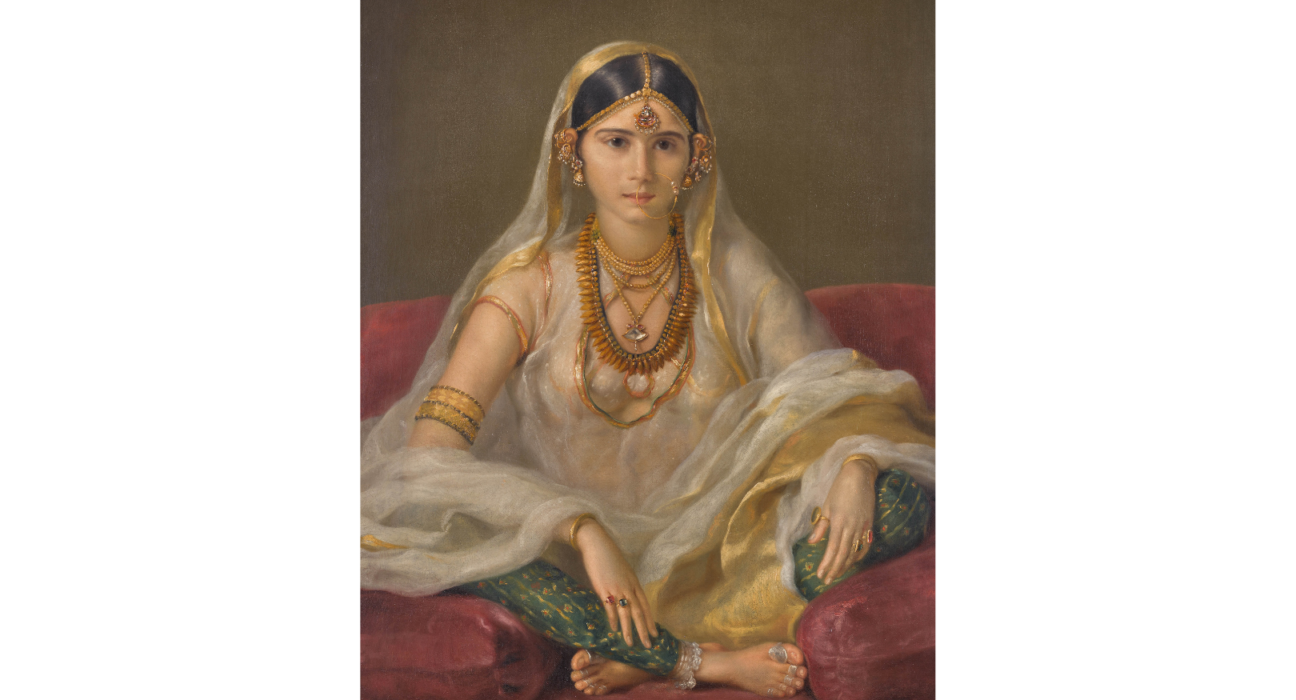A portrait of a ‘Mughal lady’ is being auctioned by Sotheby’s on 6 December by Italian-English painter Francesco Renaldi known for his three-dimensional 18th century portraits. The artwork last seen in 1969 has jumped 30,000 times in just 50 years, owing to its incredible insights into Mughal and Indian jewellery, as well as an enigmatic Indian sitter who poignantly invites you to question her identity.
From the translucence of her organza kameez to the sheen on her jet black hair and gold jewellery that catches the light, the impeccable details make it a painting that has invited a lot of interest. Elisabeth Lobkowicz, Sotheby’s Old Masters Specialist provides notes on the provenance of Renalidi’s masterpiece: “Renaldi was an international artist to start with. He is of Italian parentage and he was born in England, trained in England. And by his early 20s, he’s already really out there. He worked with the Royal Academy of Arts and in 1785, he applied to work for the East India Company, which was granted.” His time in India through history has come to be known as his most fruitful as a creative. Another painting made during this time, Muslim Lady Reclining is currently held in Yale University’s art collection and portrays a Mughal-Indian woman in a bibikhana, flanked by a hookah and enjoying a moment of leisure and quiet. The paraphernalia in the painting – embroidered juttis, an ornate rug, and her peaceful expression all add to the allure of the portrait.
View more
“He stays in India for about 10 years,” Lobkowicz gleans. “What we know is that he was allowed access to the central figures there and the leading powers at the time. And he was the most sought-after portrait painter of his time in the late 18th century, from about 1786 to 1796.” With his immense access to the nobility and rulers of Kolkata at the time, Francesco Renaldi painted women and families of incredible power. His sitter in ‘Muslim Lady’, now priced at an estimate of £300,000-£500,000, seems to portray a similar woman of social stature. Her jewellery, bedecking every uncovered surface area of her body, from the maang tikka on the head to a ring on every finger and toe, is painted in the impasto style by Renaldi to give a true-to-reality depiction of weight, sheen, style and technique of the opulent gold jewellery.
“I think it’s absolutely remarkable to see through the eyes of a European artist how they capture this aspect of Indian culture. I think the painting is a testament to India’s heritage and history of jewellery and the allure that it had and that it held for the rest of the world,” explains Nikita Binani, Sotheby’s Jewellery Specialist. “To see a representation of 18th century jewellery described in this glittering detail through the eyes of a European artist is extremely rare.” What underscores the painting is the rich jewellery artistry and heritage of wearing jewellery and the sensitivity with which it has been painted and captured by the artist.
With any such portrait of its time where the origins of the subject may be unknown, it is always tempting to find clues within paintings. Could the woman in ‘Muslim Lady Reclining’ and this sitter be related? Could they be the same? The jewellery can offer some insight. Decked in a maang tikka, nath, earrings that trim the ear in a floating fashion, all considered typical of ‘matrimony or bridal jewellery’ could indicate that she is a woman of social standing, perhaps married to a powerful ruler or noble of the time. “You can see that she is wearing either a spinel or ruby ring, along with an emerald ring, again showcasing the sensitivity with which the painter has captured the sitter and her culture,” says Binani pointing out that sapphires were not as common owing to the astrological influences associated with jewellery in Indian culture.
What makes the painting of the moment even today, and perhaps an explainer for its obscene price jump, remains its pristine condition as well as relevance even today. “The balance, harmony and brilliance of this composition makes it timeless. From the simplest standpoint, the colour scheme of the whole painting is very balanced – the painter has taken the use of very primary colours like red, yellow and green-ish blue really far. The geometry of the piece, seen in the triangular pose of the subject, and even just the harmony of the arrangement of the fabrics and the jewels make the sitter indelible. She is immediate. She is here. She is now,” says Lobkowicz of Renaldi’s style and techniques best exemplified in this piece.
Also read: A new book explores the mesmerizing magic of jail work in Indian architecture
While we may not know her identity, it is her presence, mature, yet young and innocuous in the framing of her face that invites you to question, wonder and ponder on its origins as well as its illuminating significance into heritage and Indian culture even today.


%20-%20low%20res.jpg)